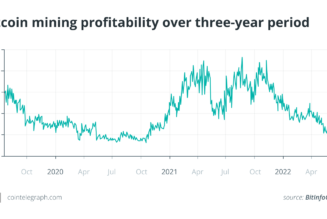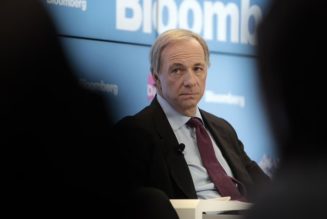
The first Bitcoin (BTC) futures exchange-traded fund (ETF) was launched in the United States back on October 19, 2021. Since then, a number of other cryptocurrency investment products have been launched in various markets.
That first ETF, the ProShares Bitcoin Strategy ETF, quicklybecame one of the top ETFs of all time by trading volume on its debut, and soon after, several other Bitcoin futures ETFs were launched in the United States, providing investors with different investment options.
To Martha Reyes, head of research at cryptocurrency trading platform Bequant, these options are important. Speaking to Cointelegraph, Reyes pointed out that in traditional finance, ETFs have “proved to be incredibly popular in recent years, with ETF assets expected to reach $14 trillion by 2024.”
Reyes said that investors who have been on the sidelines of the market may now choose to invest in cryptocurrencies if they prefer the “low cost, flexibility and convenience [of ETFs], especially as they then do not have to custody the crypto themselves.”
Custodying crypto assets, Reyes said, can prove a “technical barrier to some non-crypto natives.” The launch of crypto ETFs may offer investors the type of diversification they want in their portfolios through crypto, although some may want to access the market “via baskets reflecting different trends in this rapidly evolving market.” She added:
“Others prefer to be more hands on or have a combination of strategies. The important thing is that investors have options.”
Several options have, in fact, been launched over the last few weeks. United States-based firm WisdomTree has listed its cryptocurrency exchange-traded product (ETP), Crypto Mega cap Equal Weight ETP, on Euronext exchanges in Paris and Amsterdam.
Trading under the ticker symbol MEGA, the product is backed by physical cryptocurrencies including Bitcoin and Ether (ETH) and is rebalanced quarterly.WisdomTree also launched its WisdomTree Crypto Market (BLOC) and WisdomTree Crypto Altcoin (WALT) ETPs in Europe.
Similarly, in December, Bitcoin Capital AG released two ETPs on the SIX Swiss Exchange, offering investors exposure to Bitcoin and Ether. These products are actively managed by FICAS AG and are available to institutional, professional and private investors.
These products have so far been successful and more options are being launched on a regular basis, effectively boosting investors’ options in the market. To some experts, these products are part of the next step cryptocurrencies need to take to be widely adopted.
Investment products and adoption
To Reyes, participation in these investment products is so far “primarily institutional,” especially in countries like the United States in which only futures products are trading. She said that retail investors “are cognizant of the added rollover costs of a future versus a spot ETF, meaning underperformance versus the underlying.”
Reyes added that for “wide retail participation, we would probably need to see a spot product.”
Speaking to Cointelegraph Sui Chung, CEO of FCA-regulated crypto indices provider CF Benchmarks, said that cryptocurrency investment products are “significant drivers of mass adoption,” and while the firm would “like to see a wider choice of avenues” the impact of these products could still be significant:
“We shouldn’t underestimate the impact these products have in bringing new investors and capital to crypto assets and how this can accelerate long-term adoption.”
Karan Sood, CEO and managing director at Cboe Vest, an asset management partner of Cboe Global Markets, told Cointelegraph that increased participation from a diverse set of investors is “good for the market,” as it “increases liquidity and helps build out the market infrastructure.”
Sood said that before investing, investors should review their possibilities carefully as some products were initially launched to provide investors access to the cryptocurrency market, while others “try to provide a solution to Bitcoin’s extreme volatility problem.”
According to Sood, volatility is “endemic to the crypto asset space,” and sell-offs in which Bitcoin and other crypto assets lose over half of their value are fairly common, so much so that drops of over 20% are to be expected. He added:
“However, what is new is the availability of funds that allows investors to access Bitcoin exposure with strategies designed to reduce the impact of severe sustained declines.”
These funds, he said, take the “managed volatility set of investment strategies extensively used in conventional asset classes” and apply them to Bitcoin futures to protect investors against the cryptocurrency’s volatility.
This volatility is believed to be keeping some institutional investors on the sidelines and stopped regulators like the U.S. Securities and Exchange Commission (SEC) from finding ways to properly protect investors and accommodate for the innovation in the space.
To Chung, the cryptocurrency market has matured to the point there are now “core” exchanges like Coinbase and Kraken that ensure fair and manipulation-free trading, so market manipulation should not be a problem. Regulated products are, nevertheless, preferable for institutions and more conservative investors.
Considering the lack of a spot Bitcoin ETF in the U.S. and the disadvantages of futures-based products mentioned by Reyes above, retail investors are left either gaining exposure from other markets or buying crypto directly. These options are, nevertheless, not optimal for some.
Early stages for crypto investment products
Buying cryptocurrencies on the spot market has been the go-to strategy for most crypto investors over the last few years, but more conservative investors who may want to diversify their portfolios may be uncomfortable with the lack of regulation in the market.
As Cboe Vest’s Sood put it, when compared to the “trading and custody infrastructure that exists for conventional assets such as stocks, bonds and funds, there is little in the form of regulation.” This lack of regulation, he said, has been “exemplified by the persistent news about the loss of keys, hacking of systems and fraud in trading in crypto assets.”
Bitcoin futures investment products operate under the Commodity Futures Trading Commissions’ regulations, while mutual funds with exposure to Bitcoin are actively managed by regulated entities with a rich history of providing strong investor protections.
Taking into account these differences, Sood pointed out that “unless there is a change in the regulation of spot Bitcoin, there is a sound basis for BTC futures-based investments but not for spot-based investments.”
Notably, spot Bitcoin ETFs are available in various jurisdictions. In December, Fidelity Canada launched one such product called the Fidelity Advantage Bitcoin ETF. It trades on the Toronto Stock Exchange and is denominated both in Canadian and United States dollars.
Sood said that regulations in the U.S. may be a burden for investment product manufacturers but have “delivered substantial value and protections to U.S. investors over the years.” These protections, he said, have “stood the test of time over decades” and, as such, investors should opt for products regulated in the country if possible.
While futures-based investment products may not be optimal for retail investors, Sood argued that some sophisticated products have been launched to offer investors the cryptocurrency exposure they may be looking for. He concluded:
“Investing in funds overseas may expose U.S. investors to undue unique risks and tax burdens.“
Bequant’s Reyes pointed out that cryptocurrency ETFs have less than $20 billion in assets under management across 50 products, which means we are “still in the early stages of the adoption” of these products.
Nevertheless, she sees the approval of a futures ETF and rejection of a spot ETF as “inconsistent,” as in other jurisdictions, spot ETFs are already being traded. Making matters worse, a futures product “primarily benefits institutional investors as it is too expensive for individual investors.
Grayscale Investments has notably fired back at the SEC for rejecting VanEck’s spot Bitcoin ETF application, issuing a letter arguing the SEC is wrong to reject such products after approving several Bitcoin futures ETFs.
CF Benchmarks CEO Sui Chung said that while futures products are regulated instruments with oversight from the CFTC, it “isn’t so clear cut for spot Bitcoin,” and the SEC has a challenge in balancing its enforcement mandate with what U.S. investors want.
However, Chung noted that Bitcoin futures ETFs have already “sparked an irreversible change” as they are available “to every single member of the investing public in the world’s deepest capital market.”
Markets, he said, haven’t experienced significant disruptions and “the sky hasn’t fallen in,” meaning that we “have passed the point of no return.” To Chung, firms who can offer investors ETFs that can help diversify and grow their portfolios “will be the winners.”
Making crypto more accessible
A Bitcoin spot ETF could make cryptocurrencies more accessible but to the above experts, the crypto ETF is about more than a product with physical exposure — it’s about making cryptocurrency exposure more accessible.
To Reyes, futures ETFs trading in the U.S. are a “trial run in eventually approving a spot ETF.” Such an ETF, she concluded, would be greatly beneficial:
“A spot Bitcoin ETF would fuel mainstream retail adoption of Bitcoin further. Some investors prefer the ease of accessing the market this way rather than through dedicated crypto exchanges.”
Reyes welcomed regulation, noting that the more regulated fiat-to-crypto on-ramps there are the better, as these platforms can help signal regulatory concerns are easing, further driving up demand for cryptocurrencies.
Chung said that cryptocurrency investment products can lead to mass adoption by ensuring that investors deal with less friction when entering the market, as it may be easier to buy an ETP via an existing brokerage account than to open an account at a cryptocurrency trading platform:
“We don’t want to be dogmatic about how people invest and learn about crypto and its possibilities, our job is simply to open up as many avenues as possible and drive adoption.”
While it isn’t clear when the SEC will approve a Bitcoin spot ETF or whether existing solutions are enough for more conservative investors to make a move, new investment products are making it easier for investors to gain exposure to the space.
Over time, the trend should continue and new products will launch, allowing cryptocurrencies to fully develop in the market as a new asset class that could help hedge against inflation or economic downturns.










